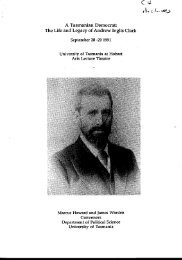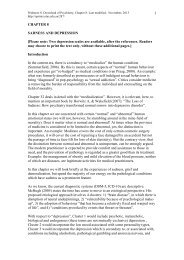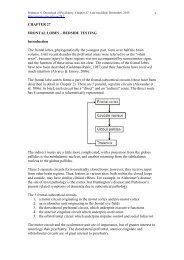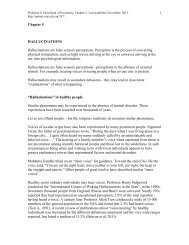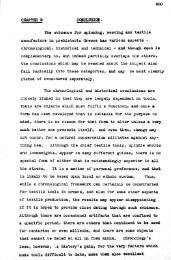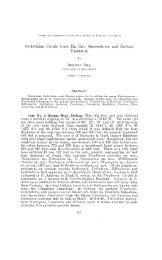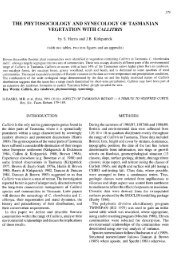PDF (Chapter 4: Delusions and Delusional Disorder) - UTas ePrints
PDF (Chapter 4: Delusions and Delusional Disorder) - UTas ePrints
PDF (Chapter 4: Delusions and Delusional Disorder) - UTas ePrints
Create successful ePaper yourself
Turn your PDF publications into a flip-book with our unique Google optimized e-Paper software.
Pridmore S. Download of Psychiatry, <strong>Chapter</strong> 4. Last modified: November, 2013<br />
http://eprints.utas.edu.au/287/<br />
1<br />
CHAPTER 4<br />
DELUSIONS AND DELUSIONAL DISORDER<br />
<strong>Delusions</strong> are false beliefs that continue to be believed in spite of evidence to the contrary<br />
(these beliefs are not held by the general public, or any sub-group of the community).<br />
A particular mental symptom may occur in different mental disorders. <strong>Delusions</strong> may<br />
occur in schizophrenia, bipolar disorder (manic or depressed phases), major depressive<br />
disorder, substance abuse <strong>and</strong> major neurocognitive disorders. In these disorders,<br />
delusions are accompanied by other signs <strong>and</strong> symptoms. <strong>Delusional</strong> disorder is an<br />
exception to the last sentence, as in this disorder, delusions are the only symptoms<br />
present.<br />
A study in anorexia nervosa (Steinglass et al, 2007) found that the fear of weight gain<br />
reached delusional proportions in 20% of cases. This is controversial. Traditionally, in<br />
this disorder, terms such as ‘over valued ideas’ <strong>and</strong> ‘irrational beliefs’ have been used<br />
rather than ‘delusion’.<br />
Body dysmorphic disorder involves preoccupation with “one or more perceived defects<br />
in physical appearance”, which are non-existent or mild. ‘Corrective surgery’ <strong>and</strong> other<br />
medical treatment may be pursued. In DSM5 this condition is listed under Obsessive-<br />
Compulsive <strong>and</strong> Related <strong>Disorder</strong>s – <strong>and</strong> when the belief is held with delusional intensity<br />
the qualification “without insight” is added – it is not listed under <strong>Delusional</strong> disorders.<br />
Mental <strong>Disorder</strong><br />
<strong>Delusional</strong> <strong>Disorder</strong><br />
Schizophrenia<br />
Bipolar <strong>Disorder</strong> (mania)<br />
Major Depressive <strong>Disorder</strong><br />
Substance Abuse <strong>Disorder</strong><br />
Comment<br />
<strong>Delusions</strong> only. No other prominent additional symptoms.<br />
Usually involve some form of persecution.<br />
<strong>Delusions</strong> may take many forms – including persecutory<br />
<strong>and</strong> bizarre. Are accompanied by at least some other<br />
symptoms such as hallucinations, problems with logical<br />
thought or self-neglect.<br />
<strong>Delusions</strong> associated with undue confidence, elation <strong>and</strong><br />
overactivity, rapid speech. Often gr<strong>and</strong>iose plans to make a<br />
fortune or establish world peace.<br />
Uncommon. <strong>Delusions</strong> consistent with low mood.<br />
Contents may include terminal illness, loss of assets or<br />
unfounded guilt.<br />
Particularly amphetamines. 13.2% of methamphetamine<br />
dependent individuals (Salo, et al, 2011). Usually<br />
persecutory.<br />
Organic Mental <strong>Disorder</strong> Variable presentations depending on the pathology. 10%<br />
of people with Parkinson disease (Mack et al. 2011).<br />
Present in almost all cases of Lewy body disease (Gaig et<br />
al, 2011).
Pridmore S. Download of Psychiatry, <strong>Chapter</strong> 4. Last modified: November, 2013<br />
http://eprints.utas.edu.au/287/<br />
2<br />
Anorexia nervosa<br />
AN patients may have fears of weight gain which reach<br />
delusional proportions (Steinglass et al, 2007).<br />
Controversial.<br />
Table. <strong>Delusions</strong> can occur in a range of mental disorders. Diagnosis is only possible<br />
after consideration of the complete clinical picture.<br />
Categories of delusions<br />
<strong>Delusions</strong> can be categorized in various ways. The following are not mutually exclusive<br />
categories; for example, a delusion may be both bizarre <strong>and</strong> systematized.<br />
Bizarre delusions are absurd <strong>and</strong> factually not possible. They may involve newly<br />
discovered gods or supernatural/space creatures.<br />
Gr<strong>and</strong>iose delusions are beliefs that the individual has exceptional beauty, intelligence<br />
or influence.<br />
Persecutory (or paranoid) delusions include that the individual is being harassed,<br />
threatened, watched or bugged. They often involve spies, bikies, God, Satan or<br />
neighbours.<br />
<strong>Delusions</strong> of reference are the belief that the everyday actions of others are premeditated<br />
<strong>and</strong> make special reference to the patient. Commonly patients complain about being<br />
talked about on television or the radio. Patients may believe that music played or words<br />
spoken on television have been specifically chosen to identify or annoy them. People<br />
crossing the street or coughing may be interpreted as purposeful actions, performed to<br />
indicate something to or about the patient.<br />
<strong>Delusions</strong> of control involve the belief that others are controlling the patient’s thoughts,<br />
feelings or actions.<br />
Nihilistic delusions are the belief that part of the individual or the external world does<br />
not exist, or that the individual is dead (Cotard syndrome, see later). Financially<br />
comfortable individuals may believe they are destitute, in spite bank statements to the<br />
contrary. Patients who believe they have no head or are dead, are unable to explain how<br />
that could be possible, but still hold the belief.<br />
Somatic delusions are false beliefs about the body. These may be bizarre or non-bizarre.<br />
A bizarre example is when the individual believes his nose is made of gold. A nonbizarre<br />
example is when the individual believes he has cancer of the rectum, in spite of<br />
negative reports from a competent doctor who has examined the rectum.<br />
<strong>Delusions</strong> of infestation/parasitosis are not uncommon in dermatological clinics (Hylwa<br />
et al, 2011).<br />
<strong>Delusions</strong> of guilt - that the individual is guilty of purposefully or non-purposefully<br />
damaging themselves, other individuals or important property. Individuals may believe<br />
they are guilty of causing the cancer of the lady who lives next door, or a drought in<br />
Central Africa.<br />
<strong>Delusions</strong> of jealousy - the belief that the partner is being unfaithful, <strong>and</strong> may involve<br />
checking the partner’s underclothes for stains or foreign pubic hairs.<br />
Erotic delusions (erotomania) - the belief of the patient that another person is in love<br />
with him or her (de Clerambault syndrome, see later). This (among others) may be a
Pridmore S. Download of Psychiatry, <strong>Chapter</strong> 4. Last modified: November, 2013<br />
http://eprints.utas.edu.au/287/<br />
3<br />
motivation for stalking, <strong>and</strong> lead to contact with the unwelcoming central figure of the<br />
delusion.<br />
Systematized delusions are united by a single theme. They are often highly detailed <strong>and</strong><br />
may remain unchanged for years.<br />
Non-systematized delusions may change in content <strong>and</strong> level of concern, from day to<br />
day or even from minute to minute.<br />
Chain Letter PUBLIC NOTICE Time For True Colours<br />
By Order of the King<br />
Please note: If I was crazy I would have been locked up by now<br />
WARNING: YOU ARE GOING TO LIVE FOREVER (Z provides absolute proof)<br />
There is a hell of a lot to the saga but some of the more interesting points<br />
of the WAR so far include my entire body verging on combustion, my brain being<br />
physically altered to the point where it is in tune with the entire universe (but it’s<br />
still me) including God, Satan <strong>and</strong> all living things, <strong>and</strong> flying fully conscious in<br />
the flesh (100% link).<br />
Be Aware: You are all in the h<strong>and</strong>s of the gods. Magic is compulsory. Have a<br />
magic day.<br />
‘Tis a fantastic tale vouched for by the fact that Bad Bill <strong>and</strong> is army of<br />
darkness are too scared to touch or even talk to me when I’ve told the whole<br />
world that they’ve done <strong>and</strong> where they’re going is no fun but my h<strong>and</strong>s are<br />
clean. The entire planet is coated with agents of Satan, they hate me just<br />
because I’ve told them the truth. Hotapur himself still tried it on occasionally but<br />
he knows he’s lost. (God <strong>and</strong> Tom incorporated)…<br />
Illustration. The above “public notice” was part of a one page document widely<br />
distributed throughout an Australian city by its writer. The full document is not presented<br />
because the second half made accusations against named people. The writer believed the<br />
owners of a coffee lounge were persecuting him. One night he burned the business down.<br />
He was jailed <strong>and</strong> died in prison, by suicide, days later. Prominent pathological features<br />
were the bizarre <strong>and</strong> persecutory delusional material, <strong>and</strong> that while disorder of the form<br />
of thought made the delusion difficult to follow, it was systematized <strong>and</strong> remained<br />
relatively unchanged.<br />
Illustration. This is a passage from a biography written by a man who subsequently<br />
drowned himself in a river. The injections referred to are injections of long-lasting
Pridmore S. Download of Psychiatry, <strong>Chapter</strong> 4. Last modified: November, 2013<br />
http://eprints.utas.edu.au/287/<br />
4<br />
antipsychotic medication. These “depot” medications help prevent relapse in psychotic<br />
disorders <strong>and</strong> can be given once every few weeks. After this man had ceased his<br />
injections for six months <strong>and</strong> his body was completely free of antipsychotic medication,<br />
he began to misinterpret the environment in a persecutory manner. He believed his<br />
friends had been “backbiting” <strong>and</strong> that a church leader (whose name has been replaced<br />
with “Anonymous”) said that he should be in prison. The writer’s name was not Peter,<br />
but another biblical name. It is reasonable to conclude that the clergyman used the name<br />
Peter by mistake <strong>and</strong> the patient failed to recognize the mistake, <strong>and</strong> concluded instead,<br />
that this misuse was purposeful. Another possibility is that the patient was hallucinating<br />
when he heard the name Peter <strong>and</strong> the comment that he (the patient) should be in prison.
Pridmore S. Download of Psychiatry, <strong>Chapter</strong> 4. Last modified: November, 2013<br />
http://eprints.utas.edu.au/287/<br />
5<br />
Illustration. The two documents above, along with a CD of other documents, were mailed<br />
to many neurosurgeons <strong>and</strong> psychiatrists at leading hospitals around Australia. The writer<br />
provided full contact details <strong>and</strong> welcomed any response. He believes that an implant was<br />
placed in his head by the CIA in 1999 <strong>and</strong> it had caused him to attempt suicide. He<br />
attributes various events over the years (Deaths of Princess Diana, Dr David Kelly, <strong>and</strong><br />
others) to the same process. These beliefs have the hallmarks of a detailed delusional<br />
system which may have been present for some years. The second letter is a response to<br />
this individual from the Australian Federal Police. He had written to them regarding his<br />
beliefs, <strong>and</strong> they responded stating they were unable to help with his complaint.<br />
Named delusions<br />
This section is added for completeness. Mention is made of some delusions which get<br />
quite a bit of attention in some books, because they are exotic <strong>and</strong> interesting. However,<br />
they are rare <strong>and</strong> are managed as any other delusion. Thus, they do not warrant much<br />
space or time. They do provide a fascinating window into psychosis.<br />
Capgras syndrome is the delusion that a person (usually a family member or someone<br />
close to the patient) has been replaced by an impostor of nearly identical appearance.<br />
This most commonly occurs in schizophrenia or organic brain disease.
Pridmore S. Download of Psychiatry, <strong>Chapter</strong> 4. Last modified: November, 2013<br />
http://eprints.utas.edu.au/287/<br />
6<br />
de Fregoli syndrome is the delusion that a person (usually a suspected tormentor) can<br />
change into different people, <strong>and</strong> many of the people the patient meets are misidentified<br />
as transformed version of the suspected person.<br />
Capgras <strong>and</strong> De Fregoli syndromes may be related. The issue may be whether the person<br />
who is misidentified is known or unknown to the patient.<br />
Folie a deux (shared psychotic disorder) is diagnosed when two people share the same<br />
delusion (Shimizu et al, 2007). Usually one of these people is psychotic <strong>and</strong> the second is<br />
not psychotic; but the non-psychotic person has come to believe what the psychotic<br />
person believes. It is common for the psychotic person to have been intelligent <strong>and</strong><br />
authoritative, <strong>and</strong> for the non-psychotic individual to be somewhat dependant. The<br />
psychotic person should be managed in the normal manner. When removed from the<br />
influence of the psychotic person, the non-psychotic individual rapidly gains “insight”.<br />
Cotard syndrome is the nihilistic (denying the existence) syndrome. It is rare in some<br />
forms, such as, when a psychotic person believes their head has been removed. The most<br />
common form may be when people with psychotic depression believe they are dead (a<br />
way of non- existence).<br />
de Clerambault syndrome is the delusion (usually held by a middle-aged single women,<br />
but not exclusively so, that another person (usually an important person) is in love with<br />
the patient. The ‘victim’ is usually unknown to the patient. The syndrome may lead to<br />
phone calls, unwanted letters <strong>and</strong> other attention.<br />
A leading, charismatic surgeon [now deceased] of Hobart, Australia, was a ‘victim’. On<br />
more than one occasion the patient presented at his offices without an appointment, <strong>and</strong><br />
disrobed in the waiting-room.<br />
Possible difference between the delusions of delusional disorder <strong>and</strong> the delusions of<br />
other disorders<br />
The following generalizations has some clinical relevance:<br />
<strong>Delusional</strong> disorder Other disorders<br />
not bizarre Bizarre<br />
Systematized Not systematized<br />
Charlton <strong>and</strong> McClell<strong>and</strong> (1999) made the observation that in delusional disorder there is<br />
fundamental mistake about the motives of others, but that thereafter, the thinking<br />
processes are logical, while in other disorders with delusions, there is evidence of many<br />
breaks in logic.<br />
Further, the delusions of <strong>Delusional</strong> disorder can be understood in an evolutionary<br />
context. The delusions of delusional disorder fit into 5 main categories: 1) belief of threat
Pridmore S. Download of Psychiatry, <strong>Chapter</strong> 4. Last modified: November, 2013<br />
http://eprints.utas.edu.au/287/<br />
7<br />
from gangs or organizations, 2) belief (particularly by the male) of infidelity of the<br />
spouse, 3) belief (particularly by females) that a high status individual is in love with the<br />
patient, 4) belief of a life threatening disease, <strong>and</strong> 5) belief of an unattractive bodily/facial<br />
deformity (in DSM5, this last example has been removed from <strong>Delusional</strong> disorders <strong>and</strong><br />
placed under Obsessive-Compulsive <strong>and</strong> Related <strong>Disorder</strong>s).<br />
Successful evolution requires the transmission of genes, which is better achieved if the<br />
individual lives a long life <strong>and</strong> is attractive to members of the opposite sex. Accordingly,<br />
the 4 categories of delusional disorder may be linked to the facts that in the ancestral<br />
environment, 1) homicide by gangs (other tribes) was a major cause of mortality, 2)<br />
infidelity by the female spouse meant the supportive male was contributing to the welfare<br />
of the genes of another male, <strong>and</strong> 3) presence of disease, or 4) deformity may reduce<br />
attractiveness to members of the other gender, <strong>and</strong> thus reduce the chances of passing on<br />
genes.<br />
[The above touches on the topic of “Theory of Mind” which is discussed in greater detail<br />
in <strong>Chapter</strong> 33.]<br />
The delusions of schizophrenia are frequently bizarre <strong>and</strong> non-systematized. This may<br />
reflect the presence of disorder of the form of thought, that is, where there is loss of<br />
logical connection between ideas.<br />
The delusions of both delusional disorder <strong>and</strong> other disorders often have some gr<strong>and</strong>iose<br />
content. It is has been observed that for a delusion of persecution (bizarre or otherwise) to<br />
be present, the individual must be “important” enough to warrant the attention of others.<br />
Unknown prevalence of delusional disorder<br />
The prevalence of <strong>Delusional</strong> disorder is uncertain. People with this disorder can often<br />
function reasonably well in the community. Lacking insight, they usually do not believe<br />
they have a mental disorder <strong>and</strong> do not go to the doctor for help. Feeling persecuted, they<br />
often avoid contact with others <strong>and</strong> try to attract as little attention as possible. In large<br />
blocks of flats there are often people who have many locks on their doors, who believe<br />
that the neighbours come into their residences <strong>and</strong> move things around or steal things<br />
during the night. Some people with delusional disorder are well known to the police as<br />
they make frequent calls about being persecuted. Possibly, most “patients” never speak of<br />
their persecution. Elderly sufferers are occasionally encountered who have been crippled<br />
by their delusions for decades.<br />
Psychology<br />
Until recently, it has been believed that <strong>Delusional</strong> disorder is not associated with<br />
cognitive deficits. However, a recent study (Ibanez-Casas et al, 2013) found, in a large<br />
cohort of people with this disorder, significant deficits in most cognitive tests.
Pridmore S. Download of Psychiatry, <strong>Chapter</strong> 4. Last modified: November, 2013<br />
http://eprints.utas.edu.au/287/<br />
8<br />
A study by De Portugal et al (2013) found that in patients with <strong>Delusional</strong> disorder, 64%<br />
had a premorbid personality disorder, the most common being paranoid type.<br />
Some “explanations” of the mechanism of delusions simply use big words for what we<br />
already know. For example, we are told that these beliefs have excessive “salience”<br />
(importance) for patients. We knew that (<strong>and</strong> I’m not paranoid, or I might be).<br />
There appears to be an inability to learn (accept) new (<strong>and</strong> contradictory) information.<br />
Subtle defects have been detected in close examination of attention <strong>and</strong> memory<br />
(Leposavic et al, 2009) of deluded people. “Prediction error” (the mismatch between<br />
what we expect in a given situation <strong>and</strong> what we really experience) has been described as<br />
faulty in people with delusions (Corlett et al, 2009).<br />
A Jumping to Conclusions (JTC) bias has been suggested in people with delusions, <strong>and</strong><br />
cognitive therapy aimed at reducing this tendency has been developed (Waller et al,<br />
2011). JTC bias, however, is not universal in this patient group (Reese et al, 2011), <strong>and</strong><br />
therapy appears to have limited potential.<br />
A recent series of 5 patients suggests an association between “ego-dystonic” gr<strong>and</strong>iose<br />
delusions <strong>and</strong> aggression to others <strong>and</strong> self-aggression (Joseph et al, 2011). At first<br />
glance we might assume that it would be pleasing to have gr<strong>and</strong>iose beliefs (in fact, it is<br />
possible the pleasure they provide is a reason they are so difficult to eradicate). However,<br />
gr<strong>and</strong>iose delusions may be “ego-dystonic”, that is the patient finds them unbearable, in<br />
which case they may be associated with aggression.<br />
Pathophysiology of delusions<br />
The pathophysiology of delusions is uncertain <strong>and</strong> probably differs from one disorder to<br />
another.<br />
Dysfunction of prefrontal <strong>and</strong> temporal lobes (Leposavic et al, 2009) <strong>and</strong> the basal<br />
ganglia (Morrison <strong>and</strong> Murray, 2009) has been suggested. Dysregulation of dopamine<br />
(hardly surprising as dopamine blockade is the most successful treatment)<br />
endocannabinoid <strong>and</strong> adenosine systems may be involved (Morrison <strong>and</strong> Murray, 2009).<br />
A recent study suggests that the insula/claustrum (a thin sheet of grey matter of unknown<br />
function between the lenticular nucleus <strong>and</strong> insula) may be “critical to the experience of<br />
delusions” in schizophrenia (Cascella et al, 2011). But, confirmation is awaited.
Pridmore S. Download of Psychiatry, <strong>Chapter</strong> 4. Last modified: November, 2013<br />
http://eprints.utas.edu.au/287/<br />
9<br />
Illustration. The insula <strong>and</strong> claustrum are named on the left.<br />
There is a suggestion that particular genes may be involved in delusions in schizophrenia<br />
(Sun et al, 2012).<br />
Management<br />
The management of people with delusions can be difficult. Particularly, where there are<br />
no other symptoms such as depressed mood, or hallucinations. Where there are other<br />
symptoms the patient may present <strong>and</strong> accept treatment for these other symptoms, <strong>and</strong> the<br />
delusions may be helped simultaneously. In delusional disorder where the patient has a<br />
single delusion (that he is the subject of a plot, for example), it may be very difficult or<br />
impossible to form a trusting patient-doctor relationship, <strong>and</strong> medication is likely to be<br />
refused.<br />
Some form of patient-doctor relationship is essential for successful treatment.<br />
Many delusions respond to adequate doses of antipsychotic medication when these can be<br />
sustained for a sufficient period (3 weeks at least; Manschreck & Khan, 2006). ECT is<br />
effective in treating the delusions of schizophrenia, <strong>and</strong> a combination of antipsychotic<br />
medication plus ECT is more effective than either alone (Zervas et al, 2011).<br />
Unfortunately, symptoms of delusional disorder often reappear when therapy is ceased,<br />
<strong>and</strong> permanent medication may be required.<br />
The prognosis for delusions becomes less favourable the longer they have been present.<br />
This is consistent with the theory that psychosis is “toxic” to the brain.
Pridmore S. Download of Psychiatry, <strong>Chapter</strong> 4. Last modified: November, 2013<br />
http://eprints.utas.edu.au/287/<br />
10<br />
Case history<br />
John Miller was 31 years of age <strong>and</strong> lived with his wife, Helen, <strong>and</strong> their five-year-old<br />
daughter, Julia, in a limestone brick house in the Adelaide foothills. John was a clerk at<br />
the Taxation Department in the city centre, <strong>and</strong> Helen worked part time as a hairdresser<br />
in a salon near their home.<br />
John’s father, now deceased, had been a motor mechanic <strong>and</strong> his mother was a registered<br />
nurse; she still worked in a nursing home. John had one sibling, Kevin, who was one year<br />
younger. They were always close companions. As boys, they kicked the football in the<br />
street every night, until it was too dark to see. At school they had plenty of friends <strong>and</strong><br />
had good relationships with their teachers, except that kicking the football left little time<br />
for homework.<br />
In high school, John, who was already nearly six-foot tall, joined the Glenelg Surf<br />
Lifesaving Club <strong>and</strong> Kevin, who was clever with electrical gadgets, started building<br />
model airplanes <strong>and</strong> yachts.<br />
Helen had always played excellent tennis. Her parents owned a take-away food shop <strong>and</strong><br />
she left school to take up an apprenticeship in hairdressing.<br />
John met Helen at the beach when he was “on duty” for the Surf Club. He was nineteen<br />
<strong>and</strong> she was seventeen years of age. He was in the first year of an Arts degree <strong>and</strong> she<br />
was halfway through her apprenticeship. John was not enthusiastic about his studies <strong>and</strong><br />
left before the end of year exams, opting for a clerical job which would leave his<br />
evenings <strong>and</strong> weekends free of work commitments.<br />
The couple spent time together at the beach <strong>and</strong> on the tennis court. They lived together<br />
for six months before they married. This union was precipitated by Helen becoming<br />
pregnant with Julia. They had one brief separation, but that was in the long forgotten past.<br />
Julia was not planned, but the couple was not taking preventive measures. They were<br />
pleased when marriage became “necessary”.<br />
John achieved little promotion at work, his prospects were limited by his lack of tertiary<br />
education <strong>and</strong> ambition. He was a fitness trainer at the local football club, he kept himself<br />
fit <strong>and</strong> was an instructor in Surf Club. Julia was a healthy, articulate child. Helen had<br />
returned to work half-time when breast-feeding finished <strong>and</strong> planned to return to full-time<br />
work when the girl was well established at school.<br />
The living gr<strong>and</strong>parents were healthy, except that John’s mother was worried about her<br />
heart, perhaps because her husb<strong>and</strong> had died from a sudden heart attack.<br />
John travelled to work each day by train. Conveniently, the Taxation Department was<br />
close to an inner-city railway station. He had accepted that staff with greater ambition<br />
would gain more promotion. He shared an office with a married woman, Penny Hope,<br />
who was a few years <strong>and</strong> one public-service level senior to him. He had a good
Pridmore S. Download of Psychiatry, <strong>Chapter</strong> 4. Last modified: November, 2013<br />
http://eprints.utas.edu.au/287/<br />
11<br />
knowledge of his area of work; he had learned what he needed to know about computers<br />
<strong>and</strong> felt secure in his position.<br />
One day Penny came back after lunch <strong>and</strong> found that John had moved his desk. Their<br />
desks had been against opposite walls. He had moved his so that it was now against a<br />
wall adjacent to hers. This wasn’t really a problem for her, but it wasn’t a good use of the<br />
space; they were now both cramped up in one half, while the other half of the room was<br />
relatively empty.<br />
While this rearrangement didn’t particularly annoy Penny – it did happen without any<br />
discussion. But then, she had no authority or responsibility regarding the positioning of<br />
fellow workers’ desks. When she asked John about it, he was evasive <strong>and</strong> said that it was<br />
“for the best”.<br />
Difficulties associated with this change emerged. They now had to share one pair of<br />
power points, while the power points on John’s vacated wall stood unused. Next day, to<br />
bring electricity to his computer <strong>and</strong> printer, John produced long extension cords which<br />
tangled around under Penny’s desk <strong>and</strong> then his own.<br />
Penny thought this was an unsightly <strong>and</strong> unnecessary mess, but again, she said nothing.<br />
She had recently found John to be tense <strong>and</strong> serious. She soon found him to be quick to<br />
take offence <strong>and</strong> prepared to argue over minor details.<br />
Any discussion they had about the taxation of multinational companies ended in an<br />
argument – even when Penny was careful.<br />
“I know you’re not one of their people, but you help them, by defending them so much,”<br />
he once said, angrily.<br />
Penny noticed that John was not working effectively. He began spending too much time<br />
checking his calculations, <strong>and</strong> was not getting through the required volume of work. Then<br />
he began doing his calculations with a pencil <strong>and</strong> paper. Because their tasks were interrelated,<br />
his slowness was reducing her output. For months, she tried to carry him. She<br />
hinted, she would be prepared to take over some of his tasks.<br />
“What are you saying?” he snapped, “So, you want to get me sacked, do you?”<br />
“Don’t be silly,” she replied <strong>and</strong> dropped the topic.<br />
Partly out of concern for him, <strong>and</strong> partly out of concern for herself, Penny went to her<br />
superior.<br />
“He seems to be unhappy or something. Perhaps it’s that he doesn’t like working in an<br />
office with a woman. But things have always been fine between us.…I don’t like to be<br />
disloyal, but he’s not getting through his work the same.…I’m afraid it’s making me look<br />
bad…. I need his figures before I can do my estimates…”<br />
“He’s not the man he used to be,” she was told. She was surprised, saddened <strong>and</strong> relieved<br />
to hear that others had noticed a change over the last year.
Pridmore S. Download of Psychiatry, <strong>Chapter</strong> 4. Last modified: November, 2013<br />
http://eprints.utas.edu.au/287/<br />
12<br />
As long as anyone could remember, John had bought his lunch at a s<strong>and</strong>wich shop <strong>and</strong><br />
eaten it with the same group of men in the staff room. In the summer he had talked about<br />
cricket, <strong>and</strong> in the winter, football. During both seasons, he had tried to recruit the sons of<br />
all new employees for the Surf Club. That had changed. Now, he brought his lunch from<br />
home <strong>and</strong> ate it alone in a park.<br />
People in other sections had begun to complain about him. In the past, when he detected<br />
inaccuracies or oversights in the work which came to him he had done the usual thing,<br />
called the authors, teased them <strong>and</strong> passed on. But, then, uncharacteristically he took one<br />
of these errors to his section head; it seemed that he could not accept an honest mistake<br />
had been made. Eventually, he said to a colleague,<br />
“Well, if you don’t want to make waves, you must be happy with what’s going on,”<br />
walked out <strong>and</strong> left the building for an hour. It wasn’t clear what he meant. It was taken<br />
as an insult; it was an awkward situation <strong>and</strong> the section head let the matter drop.<br />
Over the next few months things did not improve. John continued to be tense, snappy <strong>and</strong><br />
slow. Penny didn’t want anything said to him while they were sharing an office. She<br />
finally left Taxation <strong>and</strong> went to Customs. Still, John had not acted illegally, improperly<br />
or contrary to the Public Service Act, <strong>and</strong> there were no grounds to discipline him. But<br />
they now all knew they had a problem. The Divisional Director called John to his office.<br />
“Mr. Miller. You’ve been here for twelve years. You have been a valuable employee. But<br />
over the last couple of years, you’ve slowed down quite a bit. I underst<strong>and</strong> that you don’t<br />
mix with the other staff much. I just asked you to come up to have a chat, to see if you<br />
like it here, <strong>and</strong> whether there is anything we can do to help you work things out,” he<br />
said, in a kindly manner.<br />
“You’d better talk to my Union Representative…<strong>and</strong> my Lawyer,” said John, terminating<br />
the interview by walking out.<br />
Thus commenced a union, legal <strong>and</strong> medical wrangle which lasted for two years. John<br />
contacted his Union Representative <strong>and</strong> stated he had been threatened with the sack,<br />
without warning or reason. This was believed <strong>and</strong> repeated by the Union Representative.<br />
John’s lawyer got involved, dem<strong>and</strong>ing copies of the “charges” <strong>and</strong> the “evidence”. Then<br />
John went on sick leave, his doctor claiming that he was suffering from “nervous<br />
exhaustion”, due to “industrial harassment”.<br />
After months of discussions <strong>and</strong> letters, denials that there had been harassment <strong>and</strong><br />
agreement that there was no hard evidence, John (possibly agitated by this turmoil) made<br />
an unexpected visit to the Consumer Protection Authority. He claimed that multinational<br />
companies were colluding to reduce their taxes. His “proof” was that, because he knew<br />
had “discovered this illegal activities”, he was being victimized <strong>and</strong> threatened with the<br />
sack. This information, which strongly suggested a delusion, was conveyed to the Union,<br />
the lawyer <strong>and</strong> his general practitioner. They all protested that a person under this much<br />
“strain” could sensibly conclude that he was being victimized. Nevertheless, they all soon<br />
agreed that it would be appropriate for John to be examined by the Government Medical<br />
Officer.
Pridmore S. Download of Psychiatry, <strong>Chapter</strong> 4. Last modified: November, 2013<br />
http://eprints.utas.edu.au/287/<br />
13<br />
The Government Medical Officer, after two lengthy interviews, recommended that John<br />
be assessed by a psychiatrist. Initially John refused to see a psychiatrist, apparently taking<br />
the suggestion as an insult. A month later he agreed, “just to prove” there was “nothing<br />
wrong” with him. By the time the appointment arrived, John was doubting the wisdom of<br />
his “co-operation”. After the exchange of names <strong>and</strong> h<strong>and</strong> shaking, he made an<br />
apprehensive, but angry statement,<br />
“Everybody knows that it’s easy to silence people by saying they’re mad. They do it in<br />
Russia all the time. I’m not here for that. I won’t agree to being hypnotized or anything<br />
like that. My lawyer knows I’m here. I’m here to get a clean bill of health.”<br />
The psychiatrist was calm <strong>and</strong> respectful.<br />
“OK, sure,” she said. “My role is simply to find out what the difficulties are.”<br />
“Who pays for this?” John challenged, looking from the power points to the telephone<br />
<strong>and</strong> around the walls.<br />
“The Commonwealth Government. This meeting was requested by the Government<br />
Medical Officer. But, Mr. Miller, can you tell me what you think the purpose of this<br />
meeting is, <strong>and</strong> what has led up to it?”<br />
They sat silently looking at each other. She said nothing. He started.<br />
He said that, three years ago people in the train had started holding newspapers up in<br />
front of their faces. He realized they were giving him the message that he was being<br />
watched. He didn’t know them, but they knew him. Sometimes he would be sitting in a<br />
carriage <strong>and</strong> find himself surrounded by them. Changing carriages didn’t help, there was<br />
always at least one in every carriage. He was afraid at first but then he realized they<br />
weren’t going to do anything violent. They always had the business pages pointing<br />
toward him, showing rows <strong>and</strong> rows of stock market figures. They were from the<br />
multinationals. Their message was, don’t rock the boat, don’t increase the taxes on the<br />
multinationals.<br />
“But with respect, you don’t have much to do with government policy or deciding which<br />
companies will be prosecuted. What could you do that could hurt the multinationals?”,<br />
she asked.<br />
He explained that if he started getting tough on them, like a snowball, it would get bigger<br />
an bigger, as it went from him to others, like compound interest, <strong>and</strong> it would hurt them.<br />
Make no mistake. The proof was that they had people watching him. They had already<br />
silenced half the people in the Tax Department. Once friendly work-mates “made<br />
remarks” <strong>and</strong> he had to start keeping to himself. That led to the multinationals watching<br />
him with fibre-optic devices through power points. They also bugged his office <strong>and</strong> his<br />
computer so that he had to do most of his work with pencil <strong>and</strong> paper <strong>and</strong> shred each<br />
page as he went along.<br />
This had led to the multinationals, through mining company subsidiaries, to drill tunnels<br />
under the building, <strong>and</strong> line them with bullet-proof glass. John didn’t say precisely how<br />
the tunnels fitted in with the surveillance activities. The psychiatrist didn’t push him on<br />
the point. That was unnecessary, John was clearly out of touch with reality.
Pridmore S. Download of Psychiatry, <strong>Chapter</strong> 4. Last modified: November, 2013<br />
http://eprints.utas.edu.au/287/<br />
14<br />
John had a delusional system. He believed that multinational companies believed that he<br />
was a threat to their prosperity, as his actions may force them to pay higher taxes.<br />
Supporting this central delusion were other delusions including that the multinationals<br />
were having people give him messages in the train by holding up the financial pages of<br />
the newspaper <strong>and</strong> having him watched in a variety of ways, including via fibre optic<br />
devices hidden in the power points. He also had the delusion that the multinationals had<br />
dug tunnels under his place of work. These are persecutory delusions. Such delusions<br />
often have a gr<strong>and</strong>iose flavour – in this case a clerk, with relatively little influence,<br />
believed that powerful multinational companies were concerned that he could hurt them.<br />
He believed he was so important that they employed dozens of people to watch him <strong>and</strong><br />
even went to the enormous expense of digging tunnels under the building where he<br />
worked.<br />
This case illustrates the interesting point that people with complex delusional systems<br />
can, sometimes for years, function reasonably effectively in the community. This is<br />
possible when the delusional system is the only psychotic symptom <strong>and</strong> the delusions are<br />
limited to certain areas of life. In the case of John Miller, symptoms were most<br />
distressing when he was travelling to <strong>and</strong> from, <strong>and</strong> when he was at work. It is possible<br />
for a person with a delusional system to work through to retirement without serious work<br />
problems, particularly when the delusions do not involve the workplace. Usually, fellow<br />
workers find such people to be tense, secretive <strong>and</strong> isolative, but also, precise (because<br />
they are cautious to protect themselves) <strong>and</strong> determined. Generally, the better the<br />
individual is able to function, the slower they come to the attention others <strong>and</strong> the later<br />
they receive offers of help.<br />
It may be very difficult to obtain a clear underst<strong>and</strong>ing of the beliefs of people with<br />
persecutory delusions <strong>and</strong> to commence treatment. The nature of the condition means all<br />
attempts to discuss matters with them are interpreted as a threat or as “evidence” of a<br />
conspiracy. Believing they are being persecuted rather than sick, they “sensibly” reject<br />
the initial, <strong>and</strong> sometimes all, offers of treatment.<br />
Helen had noticed her husb<strong>and</strong> had changed. He laughed less <strong>and</strong> was often angry about<br />
the events of the day at the office. She saw this as a reaction to the additional<br />
responsibilities of fatherhood. She married John “for richer or for poorer”, <strong>and</strong> ever since<br />
they met, had known he chose to avoided stressful situations. She was glad he still had<br />
the Surf Club <strong>and</strong> the local football team to take his mind off his stress.<br />
Helen knew nothing of John’s delusional system until after he went onto sick leave.<br />
Spending more time at home <strong>and</strong> more than usually worried, he started to talk to her<br />
about being watched at work. She thought this was a terrible way to treat an employee,<br />
<strong>and</strong> that she should go <strong>and</strong> complain to the Federal Minister for Taxation. Eventually she<br />
had contact with the family doctor, the union officials <strong>and</strong> the psychiatrist, <strong>and</strong> came to<br />
know the full story. She continued to support her husb<strong>and</strong> <strong>and</strong> protested that,<br />
“He wouldn’t be like this if they didn’t keep cutting the public service work force <strong>and</strong><br />
putting more <strong>and</strong> more stress on the few who’re left”.
Pridmore S. Download of Psychiatry, <strong>Chapter</strong> 4. Last modified: November, 2013<br />
http://eprints.utas.edu.au/287/<br />
15<br />
John lacked insight, which means that he was unaware that what he believed was<br />
incorrect, unaware that he was suffering a mental disorder <strong>and</strong> unaware that he needed<br />
psychiatric treatment. By definition, if you come to accept that your belief is incorrect,<br />
you can no longer fully believe it, <strong>and</strong> you can no longer have a delusion. That is how it<br />
works in theory. In practice, interestingly, people can have partial insight, which means<br />
they may be able to see that their delusion is incorrect in fact, but continue to behave as<br />
though it is at least partly correct.<br />
John’s lack of insight made it illogical for him to accept that he needed medical help. He<br />
went to the Government Medical Officer because he wanted to keep his job in the<br />
Commonwealth Government. He therefore had no alternative but to comply with that<br />
instruction. The same thing applied to the Government Medical Officer’s<br />
recommendation that he see a psychiatrist. John finally agreed to see a psychiatrist “to<br />
prove” that he was well <strong>and</strong> that his account of events was accurate. While giving such<br />
reasons, patients sometimes also have a small degree of insight, some tiny doubts about<br />
the accuracy of their thinking, <strong>and</strong> may agree to see psychiatrists to reassure themselves<br />
that they have got things right.<br />
The psychiatrist did not get into whether or not she believed John’s story. She believed he<br />
believed it. She got him to bring his wife along. The three of them talked about “the<br />
problems” John was having at work.<br />
“Well, Mr. Miller, as you know, this is pretty much the first time Mrs Miller <strong>and</strong> I have<br />
heard about these issues. I’m sure you will underst<strong>and</strong> if we ask you to explain how some<br />
of these things started to happen?”<br />
Helen was distressed to hear the full extent of her husb<strong>and</strong>’s beliefs, but she was<br />
reassured by the psychiatrist’s composure <strong>and</strong> supportive approach. By this stage the<br />
general practitioner had a better underst<strong>and</strong>ing <strong>and</strong> his name could be used. Toward the<br />
end of the interview, the psychiatrist said,<br />
“All of us want the best for you. Worrying about all these things must be very distressing.<br />
I speak for myself <strong>and</strong> your general practitioner, Dr Chen, <strong>and</strong> I’m sure, for Mrs Miller as<br />
well. We all believe you should probably take some medicine which will help you deal<br />
with the stress you are currently under…How about that? Do you think some medicine<br />
might ease some of your distress <strong>and</strong> help you deal with things?”<br />
The suffering which is secondary to delusions takes many forms. Fear or anxiety <strong>and</strong><br />
insomnia are common <strong>and</strong> are a natural consequence of the belief that one is in dangerous<br />
circumstances. Some individuals waste money on items such as additional locks <strong>and</strong><br />
security devices, new televisions sets <strong>and</strong> telephones, <strong>and</strong> sometimes a range of<br />
unnecessary medical or scientific tests to check for levels of poisons in their blood or<br />
water tanks, <strong>and</strong> other hard evidence. <strong>Delusions</strong> frequently lead to conflict at home <strong>and</strong><br />
work (divorce <strong>and</strong> dismissal) irrespective of whether others are aware of the illness or<br />
not.
Pridmore S. Download of Psychiatry, <strong>Chapter</strong> 4. Last modified: November, 2013<br />
http://eprints.utas.edu.au/287/<br />
16<br />
Certain medicines reduce delusional thinking. They also directly <strong>and</strong> immediately ease<br />
fear, anxiety <strong>and</strong> insomnia. These secondary symptoms are often the first to subside when<br />
medicine is taken, <strong>and</strong> subsequently the delusions may weaken <strong>and</strong> resolve.<br />
John refused medication when it was first offered. He remained off work, supported by<br />
his wife <strong>and</strong> general practitioner. Helen explained the situation to his mother, who<br />
became angry <strong>and</strong> distressed. However, Helen got good support from John’s brother,<br />
Kevin, <strong>and</strong> her own parents, who began to visit more often <strong>and</strong> took their gr<strong>and</strong>daughter<br />
over night, every few nights. John continued to be troubled by his delusion <strong>and</strong> his<br />
continued absence from work placed a cloud over his employment.<br />
He could not sleep <strong>and</strong> finally accepted a medication from the psychiatrist. The next day<br />
he felt more relaxed. Two weeks later he was beginning to have doubts about the<br />
multinationals digging tunnels under the Taxation Department building. A month later he<br />
no longer believed that the multinationals had been watching him through the power<br />
points. And two months later he was free of delusions, but he was more suspicious <strong>and</strong><br />
aloof than he had been before the disorder started.<br />
John remained on medication. He remained somewhat suspiciousness <strong>and</strong> aloofness. This<br />
may have been, at least in part, a natural awkwardness, given that he now knew that he<br />
had behaved irrationally <strong>and</strong> that his fellow workers would also know, via office grapevine,<br />
that he had been diagnosed with a mental disorder. One option was to apply for a<br />
transfer to another Commonwealth department. But that would bring a new set of<br />
stresses, the need to learn a new job <strong>and</strong> meet new people.<br />
“I think I would be safer where I am,” he told Helen.<br />
She wasn’t sure what he meant by “safer”, but chose not to ask. John stayed with the<br />
Taxation Department, <strong>and</strong> bought himself a car so he didn’t have to travel with people<br />
with whom he was never again entirely comfortable. He remained married <strong>and</strong> continued<br />
as a good <strong>and</strong> loving father to his daughter.<br />
John Miller suffered a paranoid delusion. Using the DSM-IV the most appropriate<br />
diagnosis was <strong>Delusional</strong> <strong>Disorder</strong>.<br />
Reference<br />
Caig C, Valddeoriola F, Gelpi E, et al. Rapidly progressive Lewy body disease.<br />
Movement <strong>Disorder</strong>s 2011 Apr 11. doi: 10.1002/mds.23506. [Epub ahead of print]<br />
Cascella N, Gerner G, Fieldstone S, et al. The insula-claustrum region <strong>and</strong> delusions in<br />
schizophrenia. Schizophrenia research 2011; 133:77-81.<br />
Charlton B, McClell<strong>and</strong> H. Theory of mind <strong>and</strong> the delusional disorders. Journal of<br />
Nervous <strong>and</strong> Mental Disease 1999; 187:380-383.<br />
Corlett P, Krystal J, Taylor J, Fletcher P. Why do delusions persist? Frontiers in Human<br />
Neuroscience 2009. Doi: 10.3389/neuro.09.012.2009.
Pridmore S. Download of Psychiatry, <strong>Chapter</strong> 4. Last modified: November, 2013<br />
http://eprints.utas.edu.au/287/<br />
17<br />
De Portugal E, diaz-Caneia C, Gonzalez-Molinier M et al. Prevalence of premorbid<br />
personality disorder <strong>and</strong> its clinical correlates in patients with delusional disorder.<br />
Psychiatry Res 2013; Aug 27. pii: S0165-1781(13)00403-4<br />
Hylwa S, Bury J, davis M. et al. <strong>Delusional</strong> infestation, including delusions of parasitosis:<br />
results of histologic examination of skin biopsy <strong>and</strong> patient-provided skin specimens.<br />
Archives of Dermatology 2011 May 16. [Epub ahead of print]<br />
Ibanez-Casas I, De Portugal E, Gonzalez N et al. Deficits in executive <strong>and</strong> memory<br />
processes in delusional disorder: a case-control study. PLoS One 2013;8(7):e67341.<br />
Joseph Z, Victor K, Rimona D. “Ego-dystonic” delusions as a predictor of dangerous<br />
behaviour. Psychiatr. Quarterly 2011; 82:113-120.<br />
Leposavic I, Leposavic L, Jasovic-Gasic M. Neuropsychological profile of delusional<br />
disorder. Psychiatr Danub 2009; 21:166-173.<br />
Mack J, Rabins P, Anderson K, et al. Prevalence of psychotic symptoms in a<br />
Community-based Parkinson disease sample. Am Journal Geriatric Psychiatry 2011 May<br />
25 [Epub ahead of print]<br />
Manschreck T, Khan N. Recent advances in the treatment of delusional disorder.<br />
Canadian Journal of Psychiatry 2006; 51:114-119.<br />
Morrison P, Murray R. From real-world events to psychosis: the emerging<br />
neuropharmacology of delusions. Psychiatry Bulletin 2009; 35:668-674.<br />
Reese H, Mcnally R, Wilkelm S. Probabilistic reasoning in patients with body<br />
dysmorphic disorder. Journal of Behavior Therapy <strong>and</strong> Experimental Psychiatry 2011;<br />
42:270-276.<br />
Salo R, Flower K, Kielstein A, et al. Psychiatric comorbidity in methamphetamine<br />
dependence. Psychiatry Research 2011; 186:356-361.<br />
Shimizu M, Kubota Y, Toichi M, Baba H. Folie a deux <strong>and</strong> shared psychotic delusions.<br />
Current Psychiatry Reports 2007; 9:200-205.<br />
Steinglass J, Eisen J, Attia E, Mayer L, Walsh B. Is anorexia nervosa a delusional<br />
disorder? An assessment of eating beliefs in anorexia nervosa. Journal of Psychiatric<br />
Practice 2007; 13:65-71.<br />
Sun J, Jayathilake K, Zhao S, Meltzer H. Investigating association of four gene regions<br />
with five symptoms in schizophrenia. Psychiatry research 2012; March 12 [Epub ahead<br />
of print].<br />
Waller H, Freeman D, Jolley S, et al. Targeting reasoning biases in delusions: a pilot<br />
study of the Maudsley Review Training Programme for individuals with persistent, high<br />
conviction delusions. Journal Behavioural Therapy <strong>and</strong> Experimental Psychiatry 2011;<br />
22:414-421.<br />
Zervas I, Theleritis C, Soldatos C. Using ECT in schizophrenia: a review from a clinical<br />
perspective. World Journal of Biological Psychiatry 2011 Apr 12. [Epub ahead of print].






